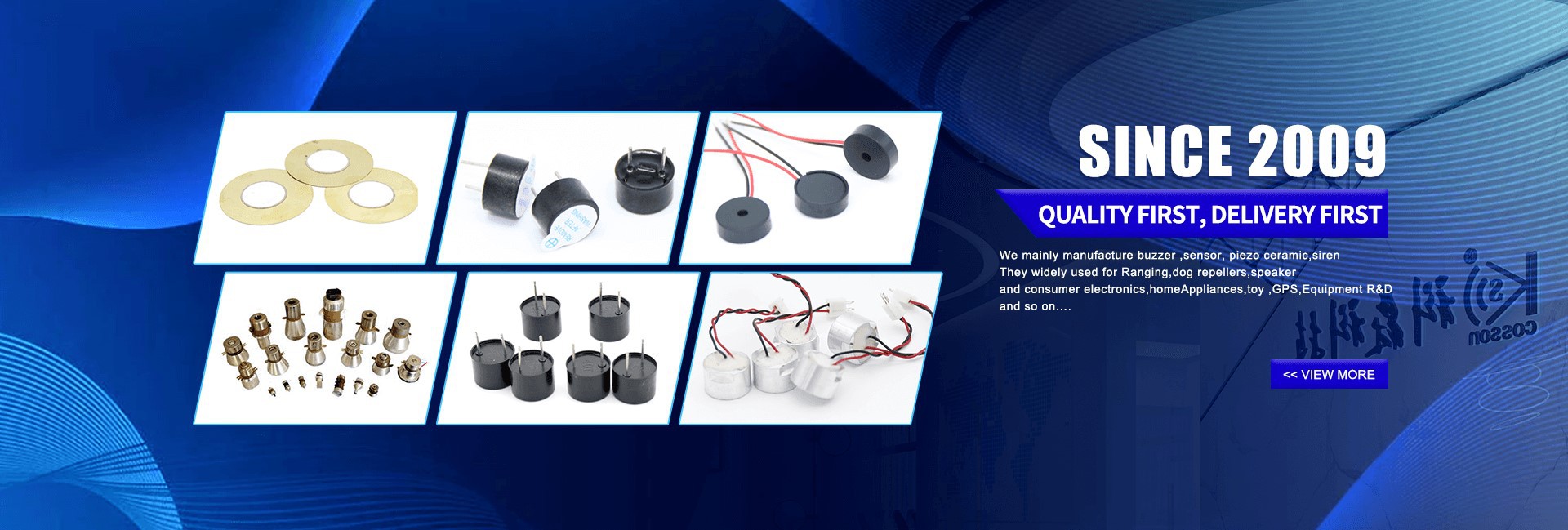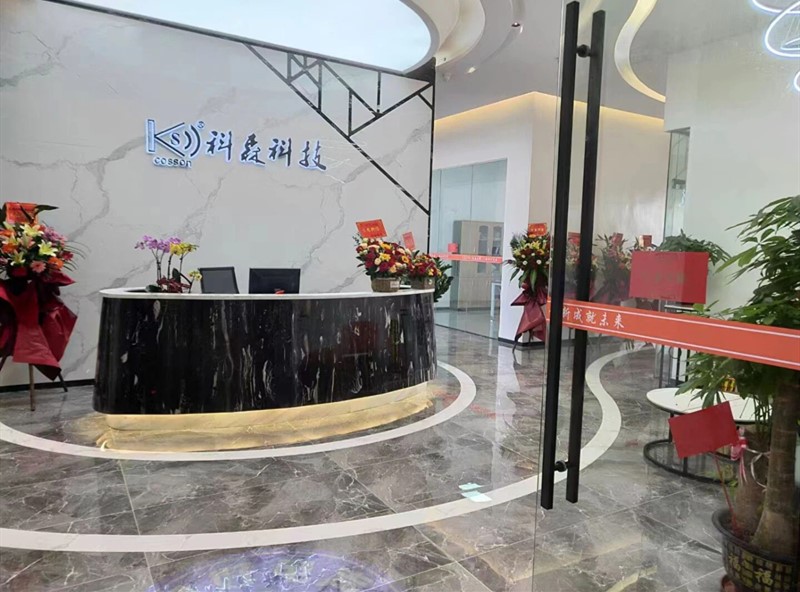Piezo Buzzer
Foshan cosson Technology Co. Ltd is a professional enterprise engaged in manufacturing buzzer,sensor, piezeceramic, speaker and so on . The company is located in Guandong. Since its inception the company spirit of "Quality first, customer first" business philosophy, full participation, excellence, to provide high-quality products for customers !
Cosson has talent, technology, quality, service, strategy and other advantages.Meanwhile,it is optimizing work flow, casting excellence, continuing to revitalize the brand to maintain the leading position, the vision of a more broad, higher goals and dedicated to creating more value for customers. The company has developed a series of products which are widely used in the production: communication, household appliances, automobiles, electric bicycles, UPS power supply, alarm; instrumentation, electronic toy and electronic clocks and so on.

Why choose us?
01
Quality assurance
Quality is our culture, we believe that the quality is the soul of an enterprise.
02
Good service
Good after-sale service, handling the customer complaint and solve problem for customers.
03
Reasonable price
Our products are complete in variety, good in quality, reasonable in price.
04
Fast delivery
We may promise that we can try our best to finish all of your orders within the shortest time.
What is Piezo Buzzer
Piezo buzzers are compact electronic devices used to produce audible alerts or notifications. They operate based on the piezoelectric effect, a property that allows certain materials to generate an electric charge under mechanical stress. This unique characteristic has made piezo buzzers popular in diverse applications, from household appliances to medical equipment and industrial machinery.
Benefits of Piezo Buzzer
Excellent electrical endurance
Since there is no moving contact part, the piezoelectric buzzer has a long life and high reliability and can be used continuously for more than 10,000 hours, which is a semi-permanent device.
Zero interference
Piezoelectric buzzer does not produce flying arc or RF noise, no interference to other circuits.
Stability
Piezoelectric buzzer does not cause large vibration due to looseness.
High functionality
There is electronic circuit control in the piezoelectric buzzer. It can issue a variety of pleasant sounds and analog sounds, intermittent sounds, pure tones, not easy to be covered by noise.
Low power consumption
There is voltage excitation in the piezoelectric buzzer. Thus the consumption of current is small, generally under 20mA, will not exceed 100mA.
Flexible profile
There is a variety of profiles of the piezoelectric buzzers. Volume can reach 70dB / 20cm, while the component thickness is only 1mm or less.
Good adaptability
The piezoelectric buzzer can work in a wide working temperature range.
Simple application
The piezoelectric buzzer is easy to install, and no electromagnetic coil and moving coil, do not have to worry about insulation deterioration and no possibility of leakage.
Ceramic piezo buzzers
Ceramic piezo buzzers consist of a ceramic plate bonded to a metal disk. The metal disk has an electrode deposited on its surface, which acts as a contact to the ceramic element. These buzzers typically operate in the frequency range from 8 kHz to 3 MHz. They are often employed where high-pitched sounds are required, such as smoke alarms, fire detectors, and intrusion alarm systems.
Plastic film piezo buzzers
Plastic film piezo buzzers consist of a thin plastic film sandwiched between two electrodes. When a voltage is applied across these electrodes, the plastic film deforms, causing a bending wave to travel along the length of the film. This bending wave generates sound waves that are transmitted into the surrounding medium. These buzzers typically operate in the lower frequency range of 8 Hz to 10 kHz. They are commonly used in devices like security systems, burglar alarms, pagers, and household appliances like washing machines and refrigerators.
What Effect does the Buzzer Material of a Piezo Buzzer have on the Sound
What are the Applications of Piezo Buzzers in Daily Necessities
Piezo buzzers are widely used in daily necessities. It can be used as the main sound-emitting component of an electronic doorbell. When someone comes to visit, the piezo buzzer will emit a "ding-dong" sound or music to remind the owner that a guest has arrived. Secondly, piezo buzzers are also commonly used in various alarm clocks and timers, which are used to sound prompts at set times to help people get up on time or complete other tasks. In addition, piezo buzzers also play an important role in toys and game equipment, providing various sound effects for toys and games to increase their fun and interactivity.
At the same time, piezo buzzers are also widely used in various household appliances, such as rice cookers, washing machines, air conditioners, etc. Among these devices, piezo buzzers are mainly used to emit operating prompts or alarm sounds to help users better understand the operating status of the equipment or detect potential problems in time. For example, when the washing machine completes the washing or dehydration process, the piezo buzzer will sound a prompt to inform the user that the clothes can be taken out; when the air conditioner fails, the piezo buzzer will sound an alarm to remind the user to repair it in time.
With the popularity of smart homes, piezo buzzers are also playing an increasingly important role in smart home devices. It can be linked with other smart home devices to achieve a more intelligent and convenient life experience. For example, when a smart home system detects an intrusion, a piezo buzzer can sound an alarm together with other security devices to remind users to pay attention to safety.
Piezo buzzers have become an indispensable part of our daily lives with their unique sounding principles and wide range of applications. Whether in homes, offices or other places, we can see it, bringing convenience and fun to our lives.
What are the Key Points in the Design of a Piezo Buzzer Driver Circuit
The drive circuit design of a piezo buzzer needs to consider several points to ensure that the buzzer can work stably and emit the required sound. Here are some key factors to consider when designing a piezo buzzer driver circuit:




Resonant frequency matching: Piezo buzzer s are designed to operate at a specific resonant frequency for maximum sound output. The driver circuit must be able to generate a signal that matches the buzzer's resonant frequency. This usually involves measuring the resonant frequency of the buzzer and designing an oscillator or multivibrator circuit to generate a signal at the corresponding frequency.
Waveform generation: Piezo buzzer s require square wave signals to drive because square wave signals effectively vibrate piezoelectric materials. When designing a circuit, you can use the PWM (Pulse Width Modulation) output of a microcontroller or a specialized oscillator circuit to generate the desired square wave signal.
Power supply voltage and current driving capability: The driving circuit should be compatible with the operating voltage range of the piezo buzzer and be able to provide sufficient current. Since a piezo buzzer may require a large instantaneous current when activated, the circuit design should take this into account, and may require the use of transistors or integrated circuits with sufficient driving capabilities.
Power consumption vs. Efficiency: In battery-powered devices, power consumption is a critical design parameter. Driver circuits should be designed to be as efficient as possible to reduce energy consumption and extend battery life. This may involve using low-power logic circuits and optimizing power management.
Noise suppression and electromagnetic compatibility: To reduce electromagnetic interference (EMI), it may be necessary to add filters or shielding to the circuit. In addition, circuit design should comply with relevant electromagnetic compatibility standards to ensure that there is no interference with other equipment.
Protection measures: The drive circuit should include overvoltage and overcurrent protection to prevent buzzer damage caused by power fluctuations or circuit failures. This can be achieved by using appropriate protection diodes, transistors or integrated circuits.
Debugging and testing: The design should be easy to test and debug. For example, you could include potentiometers for adjusting frequency and volume, or use a microcontroller with programmable outputs to adjust parameters without changing the hardware.
Why are Piezo Buzzer's Piezoelectric Crystals and Ceramic Components Highly Sensitive to Electrical Signals
Piezoelectric effect
The piezoelectric effect is a phenomenon in which certain materials, such as quartz crystals, lead zirconate titanate (PZT), and other piezoelectric ceramics, exhibit a change in shape or mechanical deformation when subjected to an electric field. Conversely, they also produce an electric charge when mechanically deformed.
Lattice structure
The high sensitivity of piezoelectric materials is rooted in their crystal lattice structure. These materials have an asymmetrical arrangement of positive and negative charges within their crystal structure. When an electric field is applied, it induces stress within the material, causing a mechanical response.
Dipole alignment
Piezoelectric materials consist of electric dipoles (pairs of positive and negative charges) that are naturally aligned in their unstrained state. When an electric field is applied, it disrupts the dipole alignment, causing the material to deform.
Electrostrictive effect
In addition to the primary piezoelectric effect, piezoelectric materials also exhibit the electrostrictive effect. This effect is responsible for the secondary deformation that occurs when the dipoles respond to the applied voltage. It further enhances the sensitivity of the material.
Direct and inverse piezoelectric effects
The direct piezoelectric effect refers to the generation of an electric charge in response to mechanical deformation, while the inverse piezoelectric effect refers to the generation of mechanical deformation in response to an applied electric field. Both effects are fundamental to the sensitivity of piezoelectric materials.
Effective conversion
Piezoelectric crystals and ceramics are highly efficient at converting electrical energy into mechanical motion. Even relatively low-voltage electrical signals can induce significant mechanical deformation, resulting in vibration and sound production.
Instantaneous response
The response of piezoelectric materials to electrical signals is virtually instantaneous. When voltage is applied or removed, the material immediately changes shape, allowing for rapid signal transmission.
Precise signal conversion
Piezoelectric materials provide precise signal conversion, making them suitable for applications requiring accuracy, such as sensors and acoustic devices.
Voltage-dependent strain
The magnitude of the mechanical deformation is directly proportional to the magnitude of the applied voltage. This linear relationship allows for fine control over the extent of deformation and sound production.

Piezoelectric ceramic disc: This is the main component of a piezo buzzer. It vibrates when an electric signal is applied, causing the production of sound waves.
Resonator: This component often takes the form of a hollow enclosure, which amplifies the sound produced by the vibrating ceramic disc.
Housing: The housing serves as a protective casing for the piezoelectric disc and resonator. It is often made from durable plastic.
How to Choose the Right Piezo Buzzer
Consider the application
Before choosing a piezo buzzer, it is important to understand the purpose of the device. For example, if you are using the buzzer in an audio application, you need to choose a buzzer that is loud and reliable. On the other hand, if you are using it in a robotics application, you need to choose a buzzer that is lightweight and durable.
Check the voltage and current
The voltage and current requirements of a piezo buzzer can vary depending on the application. For example, a piezo buzzer used in an audio application may require a higher voltage and current compared to one used in a robotics application. Therefore, it is important to choose a buzzer that meets the required voltage and current requirements.
Consider the quality of the manufacturing process
Quality manufacturing processes ensure that the piezo buzzer you are purchasing is of high quality. In addition, it helps to ensure that the buzzer will last for a long time. Therefore, it is important to choose a piezo buzzer china that is made in a high-quality manufacturing plant.
Look for certifications and approvals
Some piezo buzzers are certified and approved by relevant organizations. These certifications and approvals provide assurance that the buzzer is safe and meets relevant standards. Therefore, it is important to choose a Piezo buzzer China that is certified and approved by relevant organizations.
Certifications

Our Factory
We attach great importance to, cherish all cooperation or cooperative partner of customers, to express the trust and expectations of our customers.Cosson's team of professional skills, has a very enthusiastic, with a lofty ideals and high aspirations enthusiasm and look forward to customers, together with the Chinese The electronic industry is booming as a modest, attained brilliant. Partnership, abide by integrity, common development!We firmly believe that the goods of electronic will continue to forge ahead, and you work together to create a better future! We hope to work with all of our overseas partners.Let's do it even better!




















